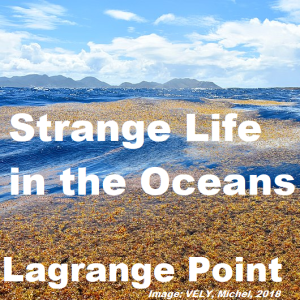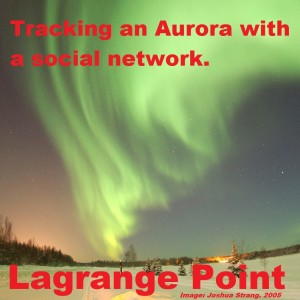-
-
Space seems so incredibly vast and empty, but there is a lot hidden inside that seemingly empty void. From fungal spores to charged bucky balls. Radiation in space seeps everywhere and makes long term space travel dangerous for humans, but fungal spores cope just fine. Radiation can also cause beautiful light shows like the aurora but can make light tough for astronauts. How can we use social media to track the beautiful aurora light shows? How do we clean a space ship or space station?
References:- L. Orr, S. C. Chapman, J. W. Gjerloev. Directed network of substorms using SuperMAG ground‐based magnetometer data. Geophysical Research Letters, 2019; DOI: 10.1029/2019GL082824
- American Geophysical Union. (2019, June 27). Space station mold survives high doses of ionizing radiation: New research presented at the 2019 Astrobiology Science Conference in Bellevue, Wa.. ScienceDaily. Retrieved July 7, 2019 from www.sciencedaily.com/releases/2019/06/190627121252.htm
- M. A. Cordiner, H. Linnartz, N. L. J. Cox, J. Cami, F. Najarro, C. R. Proffitt, R. Lallement, P. Ehrenfreund, B. H. Foing, T. R. Gull, P. J. Sarre, S. B. Charnley. Confirming Interstellar C60 Using the Hubble Space Telescope. The Astrophysical Journal, 2019; 875 (2): L28 DOI: 10.3847/2041-8213/ab14e5
Episodes

Monday Jul 29, 2019
Monday Jul 29, 2019
As the climate changes different species are at risk. Some will thrive and others will struggle, so how do we target conservation efforts to better protect at risk species? Deforestation is a big issue in developing countries, but is there a win-win for the population and the planet? When sea levels rise, we think about flooding and erosion, but not what will happen to the forests and birds who live in them. Trees in the city live fast and die young, which means we need a whole new set of forest management techniques.
References:
- Paul J. Taillie, Christopher E. Moorman, Lindsey S. Smart, Krishna Pacifici. Bird community shifts associated with saltwater exposure in coastal forests at the leading edge of rising sea level. PLOS ONE, 2019; 14 (5): e0216540 DOI: 10.1371/journal.pone.0216540
- C. David L. Orme, Sarah Mayor, Luiz dos Anjos, Pedro F. Develey, Jack H. Hatfield, José Carlos Morante-Filho, Jason M. Tylianakis, Alexandre Uezu, Cristina Banks-Leite. Distance to range edge determines sensitivity to deforestation. Nature Ecology & Evolution, 2019; DOI: 10.1038/s41559-019-0889-z
- Ian A. Smith, Victoria K. Dearborn, Lucy R. Hutyra. Live fast, die young: Accelerated growth, mortality, and turnover in street trees. PLOS ONE, 2019; 14 (5): e0215846 DOI: 10.1371/journal.pone.0215846
- Johan A. Oldekop, Katharine R. E. Sims, Birendra K. Karna, Mark J. Whittingham, Arun Agrawal. Reductions in deforestation and poverty from decentralized forest management in Nepal. Nature Sustainability, 2019; DOI: 10.1038/s41893-019-0277-3

Monday Jul 22, 2019
Episode 336 - Life frozen in time inside extreme ice
Monday Jul 22, 2019
Monday Jul 22, 2019
Ice can be refreshing and cooling, but it can also be used to preserve life. Sometimes for strangely long periods of time. So just how do you make extreme forms of ice? From 'warm ice that doesn't ruin your frozen food, to controlled ice that helps planes fly. Sometimes you can even use a diamond to make some super controlled ice. Ice can harbour life even in some extreme conditions like the frozen and UV radiated Andes. Buried in Alaska is a bacterial community frozen in time. For 50,000 years bacteria have been thriving beneath layers of frozen tundra.
References:
- Yong-Jae Kim, Yun-Hee Lee, Sooheyong Lee, Hiroki Nada, Geun Woo Lee. Shock growth of ice crystal near equilibrium melting pressure under dynamic compression. Proceedings of the National Academy of Sciences, 2019; 116 (18): 8679 DOI: 10.1073/pnas.1818122116
- Lara Vimercati, Adam J. Solon, Alexandra Krinsky, Pablo Arán, Dorota L. Porazinska, John L. Darcy, Cristina Dorador, Steven K. Schmidt. Nieves penitentes are a new habitat for snow algae in one of the most extreme high-elevation environments on Earth. Arctic, Antarctic, and Alpine Research, 2019; 51 (1): 190 DOI: 10.1080/15230430.2019.1618115
- University of Washington. (2019, July 12). Super salty, subzero Arctic water provides peek at possible life on other planets. ScienceDaily. Retrieved July 13, 2019 from www.sciencedaily.com/releases/2019/07/190712105707.htm

Sunday Jul 14, 2019
Sunday Jul 14, 2019
Water, water everywhere but not a drop to drink or nutrient for that matter. The Ocean can sometimes be a inhospitable place with barely any nutrients to survive off. Other times it can be home to large ocean spanning algae blooms. The oceans from the Pacific to the Atlantic can hold lots of secrets (even fresh water) beneath the surface. This week we look at 3 different papers which outline strange parts of the ocean, from large algae blooms to hidden aquifers.
References:
- Greta Reintjes, Halina E. Tegetmeyer, Miriam Bürgisser, Sandi Orlić, Ivo Tews, Mikhail Zubkov, Daniela Voß, Oliver Zielinski, Christian Quast, Frank Oliver Glöckner, Rudolf Amann, Timothy G. Ferdelman, Bernhard M. Fuchs. On-Site Analysis of Bacterial Communities of the Ultraoligotrophic South Pacific Gyre. Applied and Environmental Microbiology, 2019; 85 (14) DOI: 10.1128/AEM.00184-19
- Mengqiu Wang, Chuanmin Hu, Brian B. Barnes, Gary Mitchum, Brian Lapointe, Joseph P. Montoya. The great Atlantic Sargassum belt. Science, 2019; 365 (6448): 83 DOI: 10.1126/science.aaw7912
- Chloe Gustafson, Kerry Key, Rob L. Evans. Aquifer systems extending far offshore on the U.S. Atlantic margin. Scientific Reports, 2019; 9 (1) DOI: 10.1038/s41598-019-44611-7

Sunday Jul 07, 2019
Lagrange Point Episode 334 - Hidden in empty space
Sunday Jul 07, 2019
Sunday Jul 07, 2019
|
|

